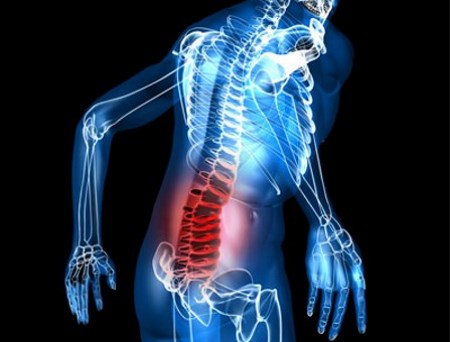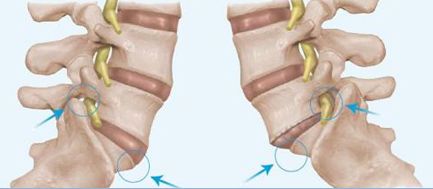Types, symptoms and treatment of retrolisthesis vertebrae of the lumbar
Retraites vertebra l5 is a medical term describing the deviation of the 5 lumbar vertebra posteriorly in comparison with the normal situation. The classic form of the disease is characterized by moderate pain in the lower back. In the initial stages it is manifested by moderate pain, which eliminated anti-inflammatory and pain drugs.
More dangerous staircase shape, which is observed at the displacement of more than 2 vertebrae. It is often when serious complications arise. Without adequate treatment may limit the mobility of the lower limbs.

Causes displacement of the vertebrae posteriorly
The Symptoms of retrolisthesis L5 depend on the etiological factors of the disease:
- Degenerative
- Dystrophic
- Paralysis
- Traumatic.
Degenerate offset l5 vertebra posteriorly occurs most often in older people against such diseases as osteochondrosis, spondylosis and scoliosis. Low back pain is the reduction of height of intervertebral disks, resulting from lesions of the intervertebral cartilages.
Degenerative changes Appear in the presence of arthrosis, subluxation and numerous injuries to the muscular-ligamentous apparatus of the spine.
Paralysis disease appears in children with cerebral palsy, which is most often congenital and is accompanied by violation of the innervation of muscle fibers.
Traumatic retraites most often localized posteriorly in the segment l3-l4-l5. It is accompanied by the classic manifestations:
- Weakness and sweating
- Paresis and paralysis
- Neurological symptoms of tension;
- Minor lower back pain in children 17-19 years old when retrolisthesis l3-l4;
- Increase in pain after lifting weights
- Aggravation and crunch at the sharp turns of the body;
- Strong backache when walking, coughing and bending the head forward;
- Numbness of the lower extremities and tingling from the pain.
what determines the forecast

Retraites lumbar spine (l4-l5) without adequate treatment leads to a favourable prognosis regarding the disability. If displacement of a vertebra in the back part of the spine accompanied by spinal cord compression, increased risk of mobility limitations of the lower extremities (paresis and paralysis).
With the defeat of the lower spine (l5-s1) patients will have disorders of urination and defecation. These symptoms caused by lesions of nerve plexus "horse's tail". Any careless movement if the infringement of the nerve roots in the lower part of the spinal column can cause irritation to the nerve that Innervate the organs of the abdomen and pelvis.
Compression of nerve roots causes pain on the back of the thighs, legs, toes. Over time, appears the syndrome of the calf muscles, the extensors of the thumb and a model of the foot. Fades ankle reflex (when we tap on the kneecap with a small hammer neurological a leg up).
Classification and diagnosis pathology
To correctly establish the diagnosis, displacement of the vertebrae, the doctors divided into the following categories:
- Full;
- Step (stair);
- Partial retraites.
In the complete displacement of the body of the overlying vertebra completely shifted posteriorly in relation to the underlying vertebra.
Stepped appearance is observed when the strain at several vertebral segments. On the radiograph they resemble a ladder, so pathology has received its specific name.
To Establish the diagnosis of posterior displacement of vertebra on the basis of radiography. Specific changes on x-ray:
- decreased height of the intervertebral disc;
- Vacuum effect of nucleus pulposus;
- Osteophytes and marginal sclerosis of the adjacent vertebrae;
- Instability of the joints.
If an x-ray does not give the desired information, used magnetic resonance imaging of the spine. On the tomograms, one can notice specific changes in the bony structure of the vertebrae, but in the condition of the soft tissue.
In the study by a neurologist, the doctor will reveal the following symptoms of tension:
- Lasegue – when bending the knees the patient flexes back;
- poor development of the muscle tissue on the affected side
- Reflex Wasserman;
- Pathological the tension of the ligaments of the knee joint.
Effective treatment

Effective treatment of retrolisthesis conducted on combined schemes. It takes into account the shape and features of the disease in each individual patient. The main task of the physician in pathology is to address the root cause of the disease.
In the initial stages is conservative treatment of the disease:
- Exceptionexercises hyperextension (arching lower back);
- execute Daily exercises to strengthen the lumbar
- Exercises for abdominal press under the guidance of a professional instructor. The main rule – the legs should be bent at an angle of 90 degrees. During exercise the amplitude of movements should be minimal;
- To improve the efficiency of procedures, you must wear a support corset and bandage;
- fitness Classes at the gym will benefit when retrolisthesis l3-l5, if they will run smoothly;
- Manual therapy together with laser therapy is used to correct the subluxations;
- Stretching the spinal column and the medication;
- the Use of pharmaceuticals together with chondroprotectors.
Good effect have hydrogen sulfide, radon, turpentine and salt baths.
If the above procedure does not bring positive results, apply surgical intervention.
You Need to understand that necrolestes l4-l5 is a serious disease that without effective treatment leads to disability. To run the pathology should not, because its consequences are dangerous and unpredictable. They never end happily without professional therapy.













